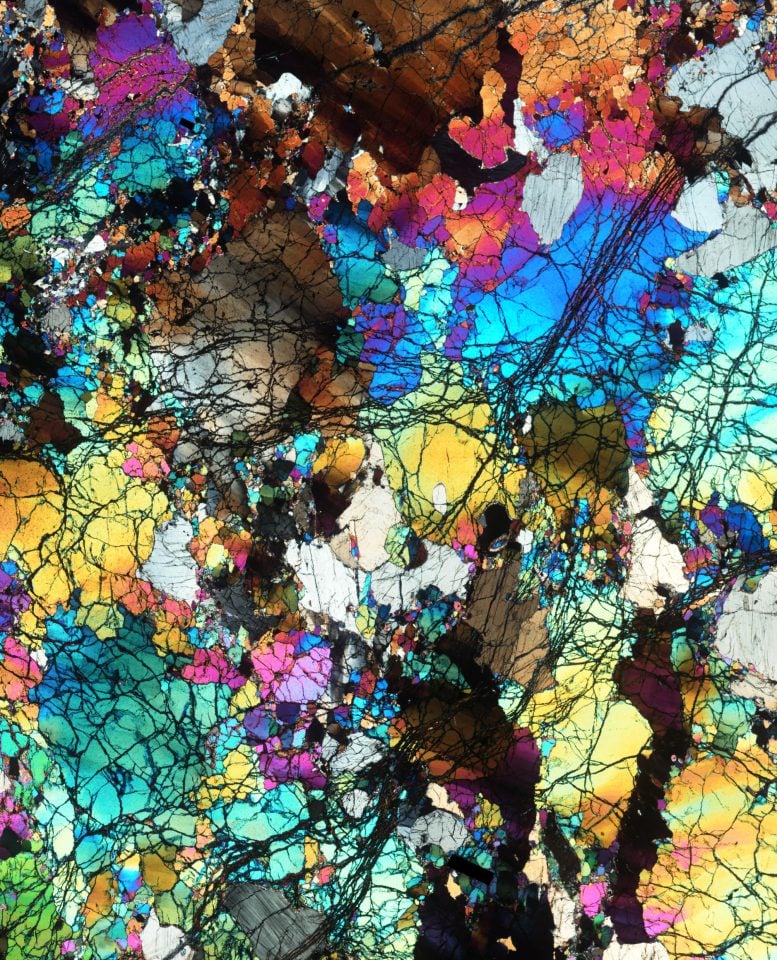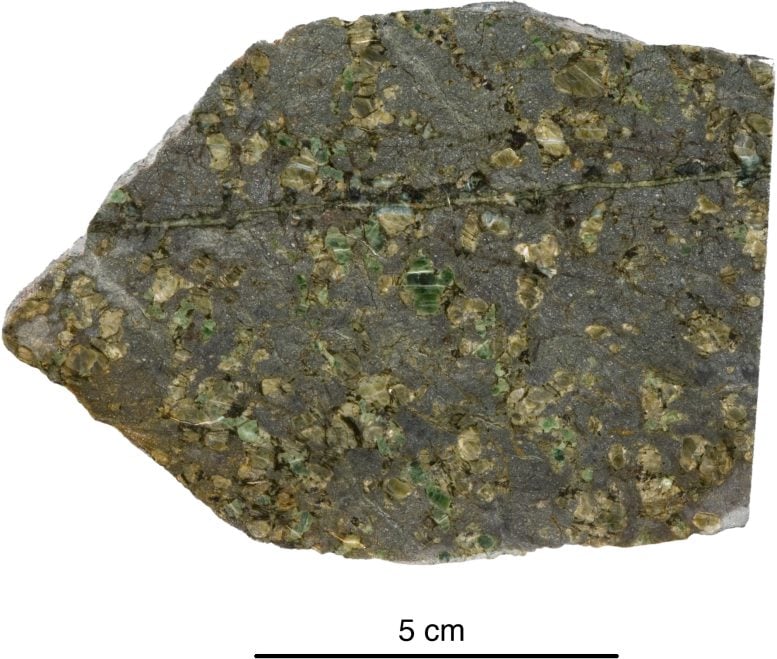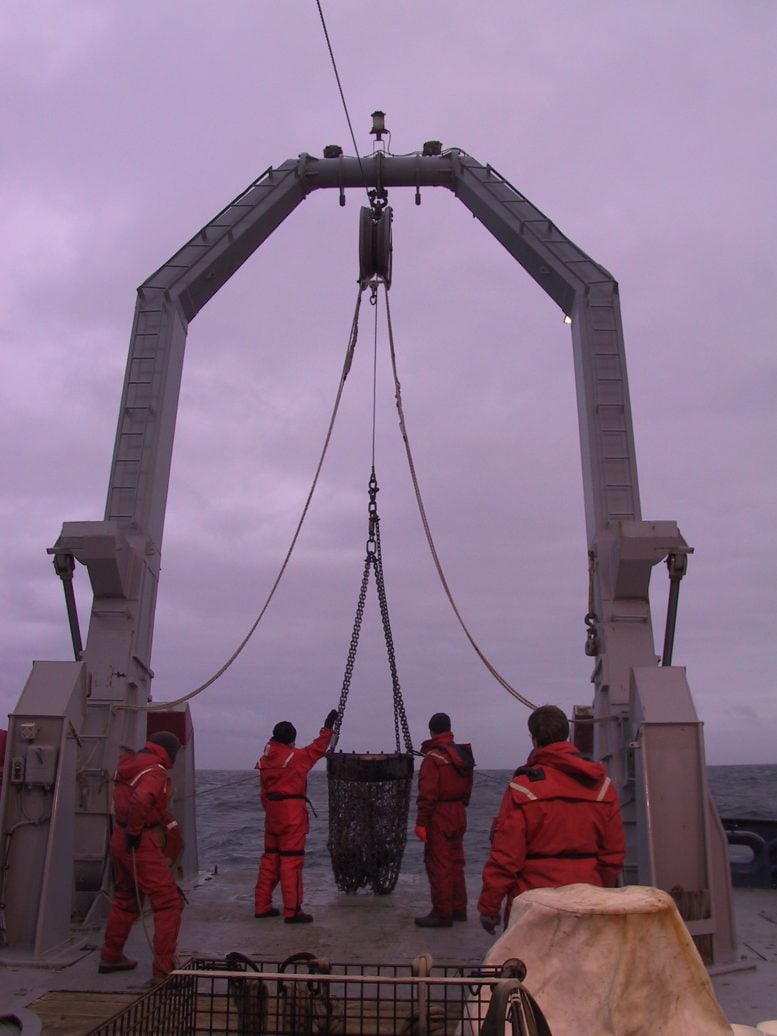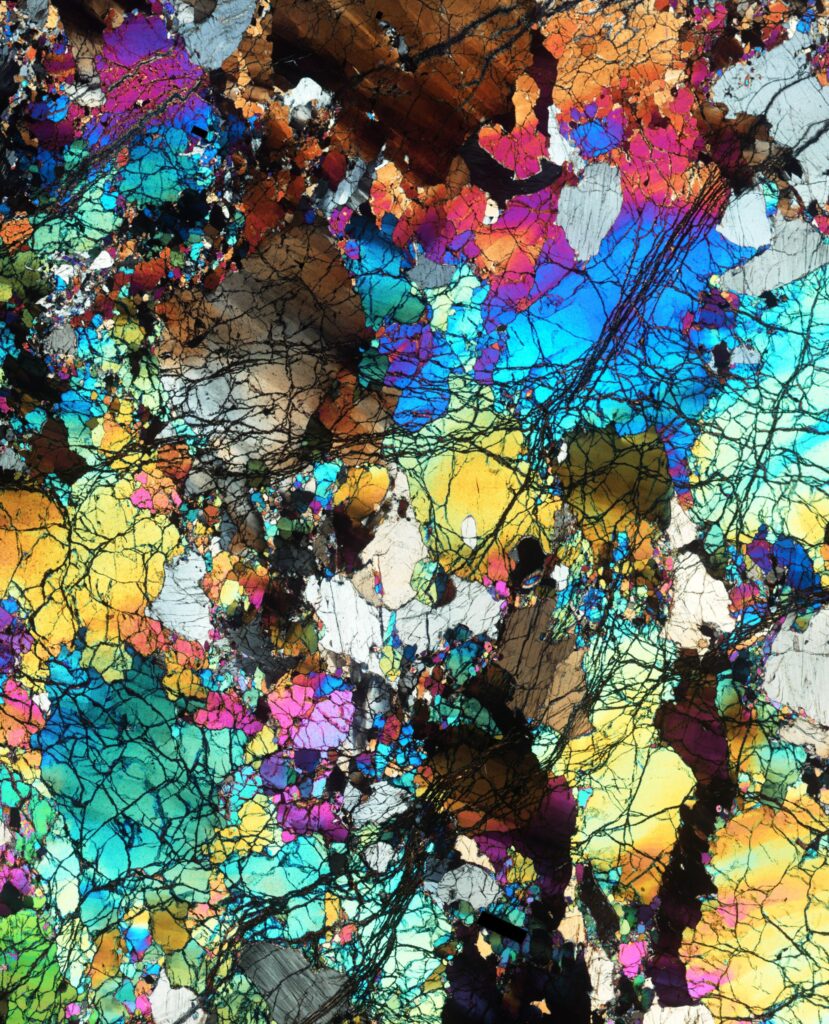
A thin section of ancient rock from the Gakkel Ridge near the North Pole is photographed under a microscope and viewed under cross-polarized light. The field of view is about 14 mm wide. By analyzing the thin rock section, geologists can identify and characterize the minerals within the rock. The analysis reveals information about the rock’s mineral composition, texture, and history, including how it formed and how it has changed since then. Researchers use the mineral identity and chemical composition of these ancient rocks from Earth’s mantle to determine the conditions under which these rocks melted. Courtesy of E. Cottrell, Smithsonian
Scientists at the Smithsonian Institution are conducting a new study of ancient “time capsule” rocks that date back at least 2.5 billion years.
Researchers at the Smithsonian’s National Museum of Natural History have conducted a new analysis of rocks believed to be at least 2.5 billion years old, shedding light on the chemical history of Earth’s mantle, the layer beneath Earth’s crust. Their findings improve our understanding of Earth’s earliest geological processes and contribute to a long-standing scientific debate about Earth’s geological history. Notably, the study provides evidence that the oxidation state of much of Earth’s mantle has remained stable over geological time, challenging previous claims by other researchers of major changes.
“This study tells us more about how this special place we live in came to be what it is today, with a unique surface and interior that allows life and liquid water to exist,” said Elizabeth Cottrell, head of the museum’s mineral sciences department, curator of the National Rock Collection, and co-author of the study. “It’s part of our human story, because our origins all go back to how the Earth formed and how it evolved.”
The study, published in Nature, focuses on a group of rocks from the ocean floor that have unusual geochemical properties: they show evidence of extreme melting with extremely low levels of oxidation, which is when an atom or molecule loses one or more electrons in a chemical reaction. With the help of additional analysis and modeling, the researchers used the unique properties of these rocks to show that they likely date back to the Archean Era, at least 2.5 billion years ago. Furthermore, the findings show that, contrary to what other geologists have previously theorized, Earth’s mantle has maintained a stable state of oxidation overall since these rocks formed.

Ancient rocks dredged from the ocean floor and studied by the research team. Photo by Tom Kleindinst
“We present evidence that the ancient rocks we studied are 10,000 times less oxidized than typical modern mantle rocks, and that this is due to melting deep in the Earth during the Archean, when the mantle was much hotter than it is today,” Cotterell said. “Other researchers have attempted to explain the high oxidation levels seen in mantle rocks today by suggesting that an oxidation event or change occurred between the Archean and the present. Our evidence suggests that the difference in oxidation levels can be simply explained by the fact that Earth’s mantle has cooled over billions of years and is no longer hot enough to produce rocks with such low oxidation levels.”
Geological evidence and research methods
The research team, which included lead study author Suzanne Berner, who completed a predoctoral fellowship at the National Museum of Natural History and is now an assistant professor at Berea College in Kentucky, set out to understand the relationship between Earth’s solid mantle and modern-day undersea volcanic rocks. The researchers began by studying rocks dredged from the ocean floor at two ocean ridges, where plates are spreading and mantle is churning up at the surface to form new crust.
The two locations where the rocks studied were collected — the Gakkel Ridge near the North Pole and the Southwest Indian Ridge between Africa and Antarctica — are two of the world’s most slowly spreading plate boundaries. The slow pace of spreading of these ridges means that volcanic activity is relatively quiet compared to faster-spreading ridges dotted with volcanoes, such as the East Pacific Ridge. This means that rocks from these slow-spreading ridges are more likely to be samples of the mantle itself.

The stern of the research vessel R/V Knorr at sea in 2004. The A-frame structure holds the giant metal-and-chain buckets that will be lowered more than 10,000 feet below the ocean’s surface and dragged along the ocean floor to collect geological samples. Photo by Emily Van Ark
When the team analyzed mantle rocks from the two ridges, they found they shared strange chemical properties. First, the rocks were much more highly molten than is typical of Earth’s mantle today. Second, the rocks were much less oxidized than most other samples of Earth’s mantle.
The researchers reasoned that to achieve such high levels of melting, the rocks must have melted at extremely high temperatures deep inside the Earth. The only other time in Earth’s geological history where temperatures this high have been recorded is during the Archean epoch, between 2.5 and 4 billion years ago. Therefore, the researchers speculated that these mantle rocks could have melted during the Archean epoch, when Earth’s interior was 360 to 540 degrees Fahrenheit (200 to 300 degrees Celsius) warmer than it is today.
Being highly molten may have protected these rocks from further dissolution that would have altered their chemical signature, allowing them to circulate within Earth’s mantle for billions of years without significantly changing their chemistry.
“This fact alone doesn’t prove anything,” Cottrell says, “but it does open the door to the possibility that this sample could be a genuine geological time capsule from the Archean Era.”
Scientific interpretations and insights
To explore a geochemical scenario that could explain the low oxidation levels in rocks from the Gakkel Ridge and Southwest Indian Ridge, the team applied several models to their measurements. The models revealed that the low oxidation levels measured in the samples could be due to melting under extremely hot conditions deep inside the Earth.
Both lines of evidence support the interpretation that the rocks’ anomalous properties represent the chemical signature of deep Earth melting during the Archean, a time when the mantle could have produced extremely high temperatures.
Some geologists have interpreted mantle rocks with low levels of oxidation as evidence that the Archean Earth’s mantle was not very oxidized and that some mechanism caused it to become more oxidized over time. Proposed oxidation mechanisms include a gradual increase in oxidation levels due to the escape of gases into space, recycling of old ocean floors through subduction, and the Earth’s core continuing to contribute to the geochemistry of the mantle. However, to date, proponents of this view have not been able to agree on a single explanation.
Instead, the new findings support the view that the oxidation levels of Earth’s mantle have remained fairly constant for billions of years, and that the low oxidation seen in some mantle samples occurred under geological conditions that Earth can no longer produce because the mantle has cooled. So rather than some mechanism that has made Earth’s mantle more oxidized over billions of years, the new study argues that high temperatures in the Archean era made parts of the mantle less oxidized. Because Earth’s mantle has cooled since the Archean era, rocks with extremely low levels of oxidation can no longer be produced. Cotterell said the process by which Earth’s mantle cooled offers a much simpler explanation: Earth simply no longer produces the rocks it once did.
By simulating the extreme pressures and temperatures found during the Archean in the laboratory, Cotterell and his collaborators now aim to better understand the geochemical processes that formed the Archean mantle rocks of the Gakkel Ridge and Southwest Indian Ridge.
Reference: “Deep, high-temperature ancient melting recorded by ultralow oxygen fugacity in peridotites,” Suzanne K. Birner, Elizabeth Cottrell, Fred A. Davis, Jessica M. Warren, 24 July 2024, Nature.
DOI: 10.1038/s41586-024-07603-w
In addition to Vilner and Cottrell, Fred Davis of the University of Minnesota Duluth and Jessica Warren of the University of Delaware are co-authors on the study.
The research was supported by the Smithsonian Institution and the National Science Foundation.


